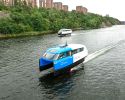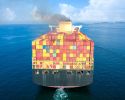Action and commitment needed for increased inland waterway shipping

It's possible to carry more freight by sea in Sweden. But the competition from road and rail is hard, writes the Swedish Maritime Administration in a report covering the potential for inland waterways and coastal shipping.
Translated from the Swedish Maritime Agency press release:
"In early 2016, the Swedish Maritime Administration in close cooperation with the Swedish Transport Administration was given the task, by the Government, to review the conditions of inland and coastal shipping and to propose measures to enhance maritime freight and passenger transport in Sweden. The result has now been presented in the form of a report.
- Shipping can, in many places in Sweden, handle more cargo without the need for any further investment in the waterways. But there is a lack of incentives for transport buyers to use shipping for domestic transport and ship owners do not see the business opportunities to engage in shipping between Swedish ports, says the Swedish Maritime Administration investigators Bjorn Garberg.
Nearly 90 percent of all goods and raw materials go by sea to and from Sweden. Historically, the shipping industry has also been important for moving goods within the country and was for much of the 1900s, the dominant mode of transport. But with rail and truck traffic development, it has been increasingly difficult for shipping to compete for the goods transported within Sweden.
- Transport time, flexibility and frequency are factors to a much greater extent than before, affecting the transport purchaser. But above all, the price for transport are crucial and it's hard for shipping to compete, Bjorn Garberg says.
The demand for shipping large volumes of cargo between Swedish ports is limited to a few industries that already use sea transport. Instead there is a great potential for short-sea shiping, based on loops that connects Swedish ports with other European ports.
- We also see that the inland waterways can relieve the traffic on the roads and reduce congestion. This includes the major construction projects around and within big cities such as in Mälardalen, Bjorn Garberg says.
One of the overall conclusions in the report is the need for extensive structural measures for inland, coastal and short sea shipping to become competitive. One suggestion in the report is to investigate instruments that can reduce the thresholds for setting up new transport services. Another suggestion is that the ports should review their price models.
- In order to increase the proportion of goods transported by sea, both the public sector and the private actors need to show great commitment and work towards the same goal, Bjorn Garberg says."
Read the full report in Swedish: www.sjofartsverket.se/IVV
-
 DNV: Metanol är ett moget alternativt bränsle
DNV: Metanol är ett moget alternativt bränsle -
 Se Hållbar sjöfarts uppsamlingsheat
Se Hållbar sjöfarts uppsamlingsheat -
 NextWave – en podd som ska locka unga
NextWave – en podd som ska locka unga -
 Ny studie: Eldrivna pendelbåtar kan effektivisera Stockholms kollektivtrafik
Ny studie: Eldrivna pendelbåtar kan effektivisera Stockholms kollektivtrafik -
 Sjöfartens utsläpp ökar
Sjöfartens utsläpp ökar -
 Sociala relationer påverkar val av bränsle
Sociala relationer påverkar val av bränsle -
 Sjöfartens omställning kräver ”mjukare” påtryckningar
Sjöfartens omställning kräver ”mjukare” påtryckningar -
 Hon hade avtalad tid med Kapten ynkrygg
Hon hade avtalad tid med Kapten ynkrygg -
 Lighthouse omvärldsanalys 2025 – osäkerhet och tullar präglar sjöfarten
Lighthouse omvärldsanalys 2025 – osäkerhet och tullar präglar sjöfarten -
 Se seminariet Shipping in the Marine Environment
Se seminariet Shipping in the Marine Environment

